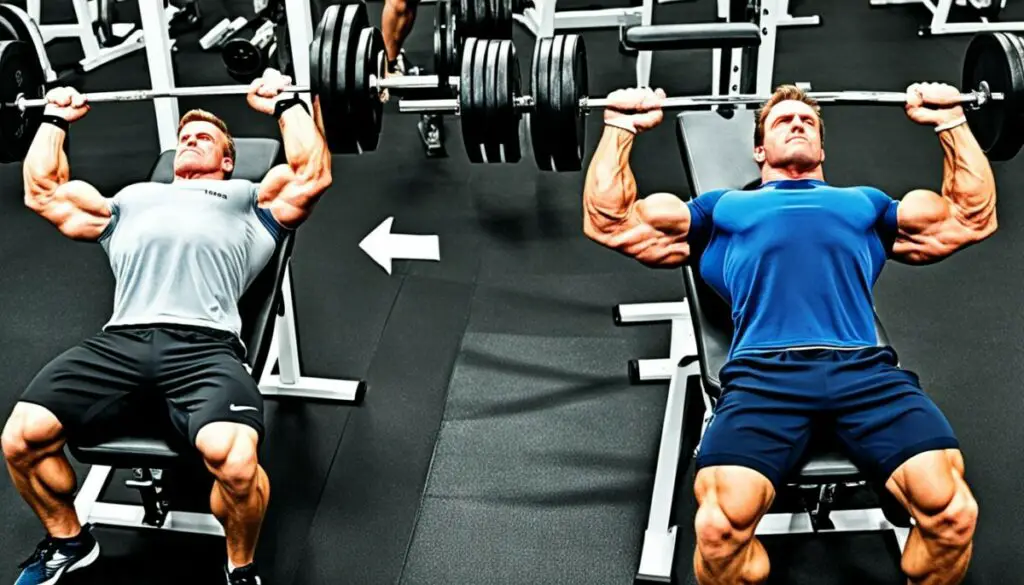Last Updated on 3 months by Francis
When it comes to strength training and weightlifting, the bench press is a fundamental exercise that targets the chest, shoulders, and triceps. There are two popular variations of the bench press: the dumbbell bench press and the barbell bench press. Understanding the ratio between these two exercises can help you optimize your training and achieve better results in terms of muscle development and strength gains.
The dumbbell bench press involves using two separate dumbbells and requires more stability and control compared to the barbell bench press. On the other hand, the barbell bench press involves using a single barbell and allows you to lift heavier weights. Both exercises offer unique advantages and can be incorporated into your workout routine to target different muscle groups and maximize overall strength training.
To convert between the two exercises, it is important to understand the weight ratio. On average, most lifters can bench press around 20% more weight using a barbell compared to using dumbbells. However, this ratio can vary depending on factors such as gender, training level, and individual strength. By understanding the conversion ratio, you can determine the appropriate weight to use for each exercise and ensure balanced and effective training.
Whether you prefer the stability and heavy lifting of the barbell bench press or the greater range of motion and muscle activation of the dumbbell bench press, incorporating both exercises into your workout routine can help you achieve a well-rounded and comprehensive strength training program.
Contents
Key Takeaways:
- Understanding the dumbbell to barbell bench ratio can help optimize your training.
- Dumbbell bench press engages more stabilizer muscles and allows for a greater range of motion.
- Barbell bench press allows for heavier weights and faster progression.
- Converting between the two exercises can help determine appropriate weight for each exercise.
- Incorporating both exercises provides a well-rounded strength training program.
The Advantages of Barbells in Bench Press

When it comes to bench press exercises, barbells offer several advantages that can enhance your strength training and help you achieve your fitness goals. Let’s explore the benefits of incorporating barbells into your bench press routine.
Lift More Weight
One of the primary advantages of using a barbell in the bench press is the ability to lift more weight compared to using dumbbells. Barbells allow you to load heavier plates onto the bar, enabling you to challenge your muscles with greater resistance. This increased load stimulates strength gains and promotes muscle growth.
Faster Weight Progression
Barbells also allow for faster progression in terms of weightlifting. Unlike dumbbells, which typically come in fixed weights, barbells enable you to make incremental increases in weight by simply adding smaller plates. This versatility allows you to progressively overload your muscles and continually push your limits, resulting in accelerated strength gains.
Enhanced Stability and Control
When performing bench press exercises with barbells, you benefit from increased stability and control. The fixed barbell provides a solid base and reduces the need for excessive stabilization from other muscles. This stability allows you to focus on lifting heavier weights without compromising form, reducing the risk of injury and ensuring effective muscle engagement.
Effective for Compound Lifts
Barbells are particularly effective for compound lifts, such as squats, deadlifts, and overhead presses. These exercises require a full-body effort and the use of multiple muscle groups simultaneously. The nature of barbell movements allows for greater load distribution across the body, making them essential for overall strength development.
| Advantages of Barbells in Bench Press | Benefits |
|---|---|
| Lift More Weight | Allows for heavier loads and stimulates strength gains |
| Faster Weight Progression | Enables incremental increases in weight for continuous progress |
| Enhanced Stability and Control | Reduces the risk of injury and ensures effective muscle engagement |
| Effective for Compound Lifts | Essential for full-body strength development |
The Advantages of Dumbbells in Bench Press

Dumbbells offer unique advantages in the bench press exercise. When compared to barbells, dumbbells engage more stabilizer muscles, resulting in a more comprehensive and effective workout for your muscles.
Dumbbell exercises also allow for a greater range of motion, enabling increased muscle activation and targeting specific muscle groups in a more controlled manner.
- Strength training: Incorporating dumbbells into your bench press routine can enhance your overall strength gains. The increased muscle recruitment from stabilizer muscles helps develop a stronger and more stable upper body.
- Muscle development: Dumbbell bench press exercises promote muscle development by engaging the chest, shoulders, and triceps more effectively. The increased range of motion allows for better muscle activation and hypertrophy (muscle growth).
- Variation and versatility: Dumbbell bench press offers various exercise variations, allowing you to target different angles and muscle groups. This versatility is especially beneficial for preventing muscle imbalances and maintaining symmetrical muscle development.
“I find that incorporating dumbbells into my bench press routine has significantly improved my chest and shoulder development. The increased range of motion and instability challenge my muscles in new ways, leading to increased strength gains.” – Mark, fitness enthusiast
Furthermore, incorporating dumbbells into your bench press routine is generally considered safer for beginners. The freedom of movement that dumbbells provide allows for better control and reduces the risk of injury.
Dumbbell Bench Press vs. Barbell Bench Press
While both the dumbbell bench press and barbell bench press have their advantages, using dumbbells can contribute to overall muscle development, strength gains, and exercise variation. By incorporating dumbbells into your workout routine, you can optimize your bench press training and achieve a well-rounded upper body workout.
Understanding the Weight Ratio Between Barbells and Dumbbells

The weight ratio between barbells and dumbbells in bench press can vary based on training level and gender. It’s important to determine the appropriate weight for each exercise to ensure balanced strength training. On average, most lifters can bench press around 20% more weight using a barbell compared to using dumbbells. However, individual strength and experience can influence this ratio.
Novice lifters may experience a higher weight difference between barbell and dumbbell bench press, while advanced lifters may have a smaller weight difference. Understanding this ratio can help you tailor your training program to your specific needs and goals.
Converting between barbell and dumbbell exercises is a useful tool in determining the appropriate weight for each exercise. By converting the weight, you can ensure that you are challenging your muscles without compromising your form or risking injury. This technique is particularly helpful when transitioning between barbells and dumbbells or when incorporating both types of exercises into your routine.
Here is an example conversion for better understanding:
| Training Level | Gender | Barbell Bench Press (lbs) | Dumbbell Bench Press (lbs) |
|---|---|---|---|
| Novice | Male | 100 | 80 |
| Advanced | Female | 150 | 121.5 |
As you can see, the weight difference between barbell and dumbbell bench press can vary based on training level and gender. It’s important to adjust the weight according to your individual strength and goals.
By understanding the weight ratio between barbells and dumbbells, you can ensure that you are challenging yourself appropriately and making progress in your strength training journey. Whether you prefer barbell or dumbbell exercises, incorporating both into your routine can provide a well-rounded and effective workout.
How to Convert Between Barbell and Dumbbell Bench Press

Converting between barbell and dumbbell bench press weight is a valuable skill that can enhance your workout planning and progress tracking. Whether you prefer the versatility of dumbbells or the stability of barbells, understanding the weight conversion is crucial. For men, the conversion ratio is typically around 0.84 from barbell to dumbbell, meaning that the weight lifted with dumbbells is approximately 84% of the weight lifted with a barbell. Women usually have a conversion ratio of around 0.81, with the weight lifted using dumbbells being roughly 81% of the weight lifted with a barbell.
To convert between the two, use the following formula:
Dumbbell Weight = Barbell Weight * Conversion Ratio
For example, if you can bench press 200 pounds with a barbell, the equivalent weight for dumbbells would be:
Dumbbell Weight = 200 pounds * 0.84 = 168 pounds (for men)
Dumbbell Weight = 200 pounds * 0.81 = 162 pounds (for women)
Converting between barbell and dumbbell bench press weight allows you to maintain consistent training intensity and progression, leading to balanced strength gains. By applying the conversion ratio, you can seamlessly transition between barbell and dumbbell exercises, providing variety and targeting different muscle groups.
The Benefits of Converting Between Barbell and Dumbbell Bench Press
- Accurate Weight Selection: Knowing how to convert between different exercise variations ensures that you select the appropriate weight for each exercise, optimizing your workout.
- Progress Tracking: Conversion calculations help you keep track of your progress in both barbell and dumbbell bench press, enabling you to set realistic goals and measure your performance.
- Versatility in Training: Converting between barbell and dumbbell bench press allows you to switch up your routine, target different muscle groups, and prevent boredom.
“Converting between barbell and dumbbell bench press weight is like speaking the language of strength training. It empowers you to confidently navigate your workout, ensuring you make informed decisions and achieve optimal results.”
So, the next time you plan your bench press workout, remember to utilize the conversion ratio between barbell and dumbbell weights. By doing so, you can enjoy the benefits of both exercises, tailor your training to your goals, and continue on your fitness journey with confidence.
| Barbell Weight (lbs) | Dumbbell Weight (lbs) |
|---|---|
| 100 | 84 (for men) / 81 (for women) |
| 150 | 126 (for men) / 121.5 (for women) |
| 200 | 168 (for men) / 162 (for women) |
| 250 | 210 (for men) / 202.5 (for women) |
Example Weight Conversions: Barbell to Dumbbell Bench Press

Understanding the weight conversion between barbell and dumbbell bench press is essential for planning your workouts and ensuring balanced strength training. Here are some examples of weight conversions based on the conversion ratios mentioned earlier:
| Barbell Weight | Equivalent Dumbbell Weight (Men) | Equivalent Dumbbell Weight (Women) |
|---|---|---|
| 100 pounds | 84 pounds | 81 pounds |
| 200 pounds | 168 pounds | 162 pounds |
These examples demonstrate how the conversion ratio can help you determine the appropriate weight to use when switching between barbell and dumbbell bench press. Remember to consider your own strength level and training goals when incorporating these weight conversions into your workout routine.
Example Weight Conversions: Dumbbell to Barbell Bench Press

Converting between dumbbell and barbell bench press weight is essential for planning your workouts effectively and tracking your progress. To help you understand the conversion process, here are some examples of weight conversions based on the earlier mentioned conversion ratios:
| Dumbbell Weight | Barbell Weight (Men) | Barbell Weight (Women) |
|---|---|---|
| 80 pounds | 94 pounds | 77 pounds |
| 120 pounds | 141 pounds | 115 pounds |
As shown in the table above, if you can bench press 80 pounds with dumbbells, the equivalent weight with a barbell would be around 94 pounds for men and 77 pounds for women. Similarly, if you can bench press 120 pounds with dumbbells, the equivalent weight with a barbell would be around 141 pounds for men and 115 pounds for women. These examples demonstrate how the conversion ratio can help you determine the appropriate weight to use when transitioning from dumbbell to barbell bench press.
Going Beyond the Numbers
Remember that weight conversions are just a starting point. It’s essential to listen to your body and adjust the weights according to your individual strength and comfort level.
The conversion ratios provided earlier (0.84 for men and 0.81 for women) are averages. However, individual differences in strength, training level, and muscle activation can influence the weight conversions. Therefore, it’s crucial to experiment and find the weight that challenges you without compromising your form or risking injury.
Additionally, keep in mind that the conversion ratios mentioned are specific to the bench press exercise. Other exercises may have different conversion ratios due to variations in the range of motion and muscle engagement.
By using the weight conversions as a guideline and making adjustments based on your own abilities, you can confidently transition from dumbbell to barbell bench press and tailor your workout to your specific needs and goals.
Understanding the Differences Between Barbells and Dumbbells in Bench Press

When it comes to bench press exercises, there are distinct differences between barbells and dumbbells. These differences can significantly impact your strength training and help you achieve your fitness goals more effectively.
Barbell Bench Press:
Barbells offer great stability and support during bench press exercises. The use of a barbell allows you to lift heavier weights compared to dumbbells, making it an excellent choice for strength-focused training. The barbell bench press primarily targets major muscle groups such as the chest, triceps, and shoulders.
Dumbbell Bench Press:
Dumbbells, on the other hand, provide a different set of advantages for bench press exercises. Using dumbbells engages more stabilizer muscles to maintain balance and control throughout the movement. This increased muscle engagement can lead to greater muscle activation and development. Dumbbells also allow for a wider range of motion, resulting in enhanced muscle flexibility and strength gains.
Both barbells and dumbbells have their own unique benefits and can complement each other in your strength training routine. Incorporating both into your workout regimen can provide a well-rounded approach to bench press variation.
The Importance of Incorporating Both Barbells and Dumbbells in Bench Press
To maximize your strength gains and muscle development, it is important to incorporate both barbells and dumbbells in your bench press. While barbells allow for heavier weights and more efficient progression, dumbbells provide a more comprehensive workout for your muscles and can help maintain symmetry. By starting your workouts with heavier barbell movements and then incorporating dumbbell exercises, you can get the best of both worlds and optimize your bench press training. Additionally, using both types of equipment can add variety to your workout routine and prevent plateaus.
When it comes to strength training, incorporating both barbells and dumbbells in your bench press routine offers unique advantages. Barbell bench presses allow you to lift heavier weights, which is essential for building strength and increasing muscle mass. The stability provided by the barbell allows you to focus on your primary muscles and progressively increase the load as you become stronger. However, relying solely on barbells for your bench press can limit the engagement of stabilizer muscles and limit your overall range of motion.
On the other hand, dumbbell bench presses require more stabilization and coordination, engaging additional muscles to control the movement and balance the weights independently. This results in a more comprehensive workout that targets both the primary and stabilizer muscles. Dumbbells also allow for a greater range of motion, enabling better muscle activation and development. By incorporating dumbbell exercises into your bench press routine, you can improve muscle imbalances and ensure balanced muscle development.
By alternating between barbell and dumbbell bench presses in your training sessions, you can maximize your strength gains and muscle development. Start your workout with barbell bench presses to focus on heavy lifting and building strength. Use progressively heavier weights with proper form and technique. After completing your sets with the barbell, incorporate dumbbell bench presses into your routine. Focus on maintaining proper form, controlled movements, and targeting your stabilizer muscles. This combination of exercises will activate a greater number of muscle fibers and improve overall muscle development.
Incorporating both barbells and dumbbells in your bench press routine also adds variety and prevents plateaus. Your muscles can adapt to repetitive motions and plateau in strength gains. By incorporating different exercises, equipment, and changing your training routine, you can challenge your muscles in new ways and continue to make progress. Adding variety not only keeps your workouts interesting but also provides the necessary stimulus for muscle growth and improved performance.
The combination of barbells and dumbbells in your bench press routine offers a well-rounded approach to strength training and muscle development. It allows you to target different muscle groups, improve overall strength, develop muscle symmetry, and introduce variety into your workouts. Incorporate both types of equipment in your workout routine to optimize your bench press training and achieve the best results in terms of strength gains and overall fitness.
Barbells vs Dumbbells in Bench Press: A Well-Balanced Approach
When it comes to barbells vs dumbbells in bench press, incorporating both types of equipment into your training is the most effective approach. Barbells are ideal for strength-focused training, while dumbbells provide unique benefits for muscle development and overall stability.
By using both barbells and dumbbells, you can target different muscle groups and optimize your training volume. This well-balanced approach helps prevent muscle imbalances and ensures comprehensive strength gains.
Barbell bench press exercises are known for their ability to allow you to lift heavier weights, making them a staple in strength training. The barbell provides stability and control during the lift, allowing you to maximize your strength gains. It also allows for smaller weight increments, enabling steady progress in your weightlifting journey.
On the other hand, dumbbell bench press exercises engage more stabilizer muscles, resulting in a more comprehensive workout for your muscles. The range of motion is greater with dumbbells, leading to better muscle activation and overall development. Dumbbells also provide more control during the movement, reducing the risk of injury, especially for beginners.
By incorporating both barbell and dumbbell exercises into your bench press routine, you can take advantage of their respective strengths and ensure balanced muscle development. Starting your workout with heavier barbell movements and then transitioning to dumbbell exercises allows you to target different muscle fibers and push your training to the next level.
“Using both barbells and dumbbells in my bench press routine has helped me achieve remarkable strength gains while ensuring my muscles are well-developed and symmetrical. The combination of heavy barbell lifts and focused dumbbell exercises has transformed my physique.” – Sarah Thompson, Fitness Enthusiast
Integrating barbells and dumbbells in your workout routine also adds variety and prevents plateaus. By constantly challenging your muscles with different equipment, you can break through training plateaus and continue progressing towards your fitness goals.
Remember, a well-balanced approach to bench press training includes a combination of barbell and dumbbell exercises. Embrace the advantages of both types of equipment to optimize your strength training, build muscle, and achieve overall fitness.
Conclusion
In conclusion, understanding the dumbbell to barbell bench ratio is crucial for optimizing your strength training and muscle development. By converting between the two exercises, you can determine the appropriate weight for each exercise and incorporate both barbells and dumbbells into your workout routine.
Both the dumbbell bench press and the barbell bench press offer unique advantages that can enhance your fitness journey. The dumbbell bench press engages more stabilizer muscles and allows for a greater range of motion, making it ideal for targeting specific muscle groups and developing muscle symmetry. On the other hand, the barbell bench press allows you to lift heavier weights, promoting overall strength gains and efficient progression.
It is highly recommended to include both barbell and dumbbell exercises in your bench press training program. This balanced approach will help you achieve well-rounded results in terms of strength, muscle development, and overall fitness. Incorporating a variety of exercises using different types of equipment ensures that you target all the necessary muscle groups and reduces the risk of muscle imbalances and plateaus. By finding the right ratio between the two exercises and customizing your workout routine accordingly, you can maximize your strength gains and reach your fitness goals more effectively.
FAQ
What is the dumbbell to barbell bench ratio?
The dumbbell to barbell bench ratio varies based on factors such as gender, training level, and individual strength. On average, most lifters can bench press around 20% more weight using a barbell compared to using dumbbells.
What are the advantages of barbells in bench press?
Barbells allow you to lift more weight compared to dumbbells, provide more stability and control during the lift, and allow for faster progress in terms of weightlifting due to smaller weight increments.
What are the advantages of dumbbells in bench press?
Dumbbells engage more stabilizer muscles, allow for a greater range of motion, provide a more comprehensive workout for your muscles, and can be safer for beginners to learn the basic movements of bench press.
How can I convert between barbell and dumbbell bench press weight?
To convert between the two, simply multiply the weight lifted with one exercise by the appropriate conversion ratio. For men, the conversion ratio is typically around 0.84, while for women, it is around 0.81.
Can you provide some examples of weight conversions from barbell to dumbbell bench press?
Sure! If you can bench press 100 pounds with a barbell, the equivalent weight with dumbbells would be around 84 pounds for men and 81 pounds for women.
Can you give me some examples of weight conversions from dumbbell to barbell bench press?
Of course! If you can bench press 80 pounds with dumbbells, the equivalent weight with a barbell would be around 94 pounds for men and 77 pounds for women.
What are the key differences between barbells and dumbbells in bench press?
Barbells offer more stability and allow for heavier weights, while dumbbells engage more stabilizer muscles and provide a greater range of motion.
Why is it important to incorporate both barbells and dumbbells in bench press?
Using both types of equipment allows you to target different muscle groups, optimize training volume, and prevent muscle imbalances.
What is the most effective approach in barbells vs dumbbells in bench press?
The most effective approach is to incorporate both types of equipment into your training, using barbells for strength-focused training and dumbbells for muscle development and stability.









